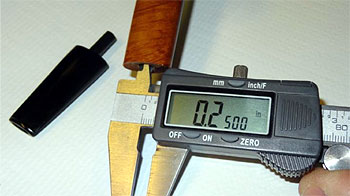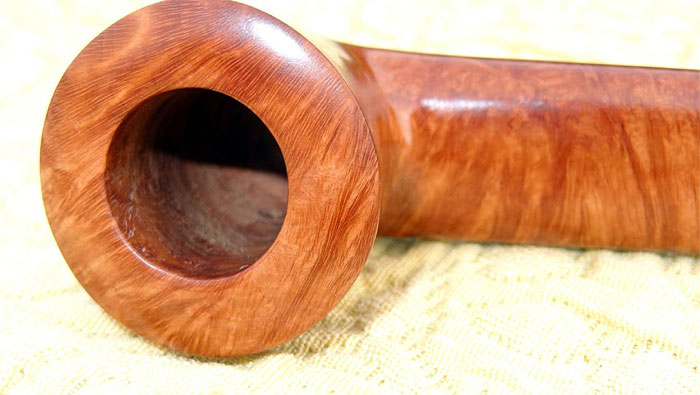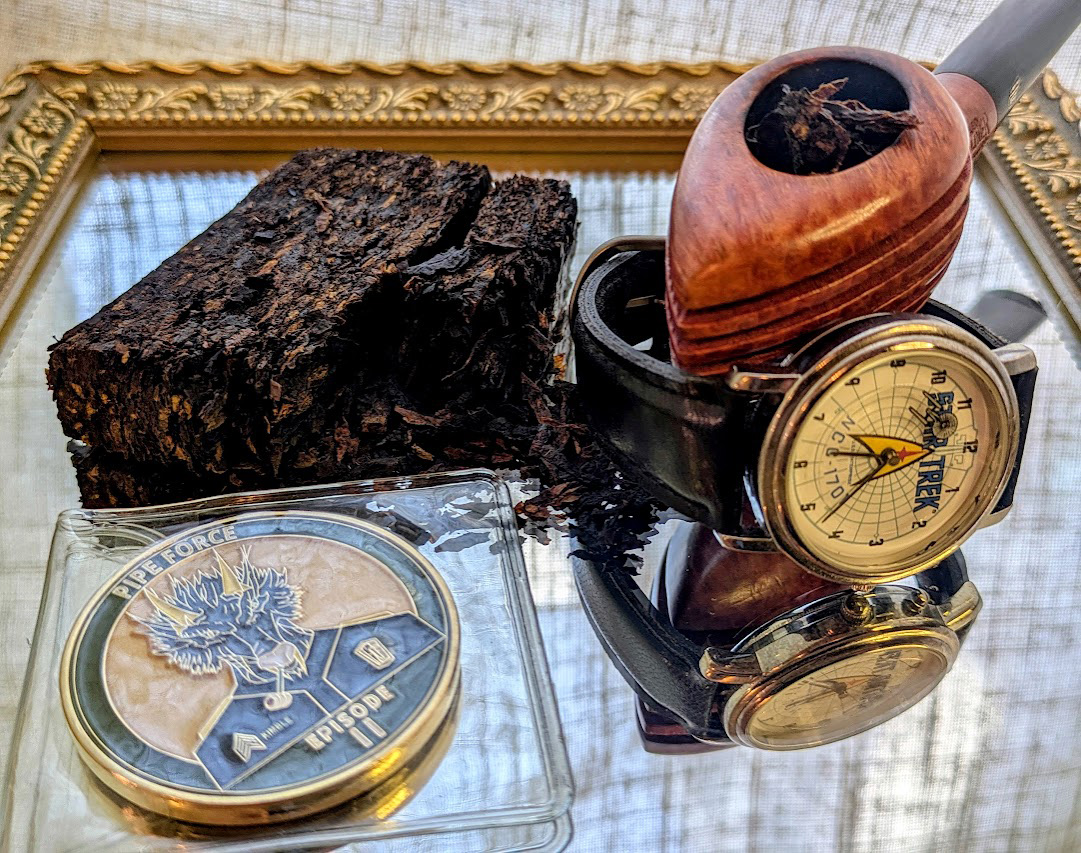One of the benefits to being employed by a major firearms manufacturer by day is the occasional business trip that might take you to exotic locales, both foreign and domestic. Of those benefits, one of the better is the very occasional ‘down time’. This is just one such event. I arrived in sunny Las Vegas, having left an icy cold and snow covered Seattle this morning at about 11:30 AM. Having been informed that my tertiary services on the convention floor would not be needed the rest of this day, I decided to do what any self respecting man with a little time on his hands in Las Vegas would do; review a quality pipe!
I know the title to this review may have thrown you off a bit. This IS about a tobacco smoking pipe, and not a streaking Irishman. But the pipe however is aptly named by its creator, and worthy of a closer look.
As always, each new pipe that is sent for review is anticipated with great excitement. This one was no different. With the pipe crafter coming with high compliments and recommendations as an ‘up-and-comer’ in this industry, I was anticipating its arrival all the more. That being the case, when the pipe arrived, alas, I was not home. When I finally did see the pipe in person later that same day, my first impression was good. This pipe has appeal.
The last couple of reviews I did have been on rusticated or blasted pipes. I wanted to go a different route this time and look over something smooth and un-textured. I also wanted to take a look at a pipe from someone in the industry that might not be getting a lot of press. I contacted a good friend and pipecrafter himself, asking for recommendations along these lines and he immediately replied with the name Jared Coles. His response was simply, "check this guy out."
 Hailing from California, Jared (half of J&J Artisan Pipes, with John Klose being his partner), is not only an up-and-comer, he’s a young fella too. Many pipe crafters I have met over the years become pipe makers themselves only after having been in the hobby of collecting, selling, trading and smoking for many, many years. For others, they are attracted to the world of pipes, and are immediately taken in by the industry and jump in with all the gusto of Carl Lewis at a high school track meet. Jared is the latter.
Hailing from California, Jared (half of J&J Artisan Pipes, with John Klose being his partner), is not only an up-and-comer, he’s a young fella too. Many pipe crafters I have met over the years become pipe makers themselves only after having been in the hobby of collecting, selling, trading and smoking for many, many years. For others, they are attracted to the world of pipes, and are immediately taken in by the industry and jump in with all the gusto of Carl Lewis at a high school track meet. Jared is the latter.
In asking Jared how this Naked Dublin came to be, I received an intuitive response. As any pipecrafter knows, the block of material being used often dictates what the end product will be. In his own words, Jared said, "Because briar… is full of nature’s lovely surprises, any plans [that a crafter has] for a pipe have to constantly be changed and rearranged, so a pipe (or any act of creation) can be thought of as a series of fixed mistakes…"
In short, his response leaves him open to whatever the briar reveals to him, bowing to the demands of the raw material. This is the classic give-and-take or the artisan. Nothing looks worse than forcing a round-peg design plan into nature’s square hole.This wisdom coming at such a comparatively young age, did not suddenly appear by accident. Rather, it came by design using desire, drive, and a bit of timely good luck. In his early days in the industry Jared, in the spirit of jumping in feet-first, put a few pipes together and headed off to a west coast pipe show. This is where the desire and drive, met good luck… and Jeff Gracik. Jared was able to meet and build relationships with several well known pipe celebrities at the event including Jeff Gracik and others. "I got to spend considerable time in his [Jeff’s] shop watching him at his craft, and then make a pipe under his tutelage. Jeff has been incredibly generous with me, with time, and some materials. He is, in my opinion, along with Todd Johnson, the definition of the American aesthetic."
I love asking pipe craftsmen this same question when reviewing a pipe: How did you come about making this pipe? Remembering the aforementioned "nature’s little surprises" of the briar, I am always curious if the pipe in-hand is what the crafter originally envisioned that block of briar to be, or whether it is a result of a composite of compromises based on changes demanded by nature along the way. When I asked Jared this question, here’s how he responded, "That Dublin was mostly just a happy accident. I’ve found that there are two kinds of good pipes: the kind where the briar speaks to you … and the kind where you speak to the briar…" Anyone who’s ever tried to craft a pipe would be so lucky as to interpret what the briar was speaking to them in the way that Jared has with this sampling he provided. In the end, he allowed that block of briar to talk him into this little beauty as a result. A happy accident, indeed.
I’m a sucker for a long shank pipe. Love them, always have. But many such pipes (Canadians, Lumbermans etc.) with their traditional long shanks, exhibit designs that are sometimes thin and very lightweight. In a real world scenario, just throwing one made this way into the pocket of your field coat for a day of cutting fire wood or working a fence-line might not be the best of ideas for many long shanked or Canadian style pipes. Not so with this offering by Jared.
Smaller in stature, but certainly not a ‘mini’ as we might call it, this Dublin shaped beauty is an unrusticated, unblasted, unstained and undefiled example of quality craftsmanship using the medium of briar. Designed in the Canadian style as I just mentioned, this Dublin is crafted with a thick and wide oval shank which I really like. Frankly, it reminds me of the old ‘whales-tail’ spoiler on the back of a 1980’s vintage Porsche 911 Carrera. Classy and a little intimidating – in a good way.
The width of the shank feels ‘manly’ and strong in my hands. Additionally, the shank which tapers from nearly an inch at the base of the bowl to about .850" at the stem, makes what otherwise might feel like a small pipe, feel more like a full-size model. In this manner, Jared does an excellent job of engineering a full size feel into what is otherwise a diminutive finished product.
The reality is that this pipe is svelte, weighing in at a mere 33.3 grams in total, so in every sense, lightweight. Uniquely slender yet bold, this pipe holds a conventional Dublin shape and comes across as polished and suave in character, yet masculine despite its diminutive stature. It was advertised as having a beautiful cross grain, which of course it does. But this blends seamlessly in its construction and discreetly in its grain from the beautiful cross grain into areas of flaring fire-grain, and even small pockets of piercing bird’s-eye on the front of the bowl.
The stem on Jared’s Naked Dublin is longer and sturdier than you might find on a lot of Canadian style offerings and differs somewhat from the norm. The very width of the shank alone requires the stem to be full-bodied as well. That being said, the stem it is esthetically beautiful. It arrived polished to a bright mirrored finish, made from select German Ebonite.
 |
 |
The shank on this sample is roughly 2.25" long and houses a ¼" tenon and no banding. The mortise fit is excellent; tight, but not too tight, leading into a 5/32" airway. The large size of the shank makes the tenon ‘feel’ small, and so a delicate touch to removing the stem is going to be naturally developed, but at the same time, probably not as necessary as one might think. In the end, functionally, the stem is superior to more fragile designs of this type that I have seen. In short, I like it. It will stand up to the rigors of a good day’s work on the farm.
The bowl is generous for its size, cut with a ¾" chamber, designed by its crafter for flake or ready rub use. It has a slight forward tilt like that which almost defines a Dublin, and a vent hole that enters the heel of the bowl precisely dead-center and exactly at the base of the bowl cut. The rim is thick and smooth which aids not only in keeping the pipe clean, but provides an esthetic plane to catch the eyes all pipe gawkers (you know the type), laying before them a delicately polished convex shaped rim, and a beautiful cross-cut grain.
It always amazes me what gets pulled out of a block of briar, when all the finish is just a good polish. Naturally it takes on a bit of shading from the Tripoli during the polish, but this briar shows great contrast in the grain in its natural state. Naked this briar came into the world, and naked this Dublin was made. The pipe is a bright piece of nature crafted by the clearly skilled hands of a man bent on being successful. From carving his first pipe in 2009, to the results we see in all of his works today, this Dublin is simplicity personified.
If I were to find any criticisms in this pipe it would be minute in detail and lack any significant impact on the overall quality or value of the pipe. I noticed that the tobacco chamber was not as smooth as I have seen in some pipes. I was not sure if this was a design technique, a deficiency or simply be the result of one of ‘nature’s little surprises’. Upon inquiring however, it was revealed to me by Mr. Coles that he sands the bowls, "…to 220 and give [it] a light oil cure. I feel that a slightly rougher interior makes the cake build faster."
Lastly, while it is not visibly noticeable, if you carefully feel the bowls exterior dimensions by rotating the pipe over your index finger, it does exhibit some facets. For a handmade pipe, I personally do not see these as deficiencies, as much as I do view them as added character.
To see someone enter into the craft at such a young age is not only unique, I hope it is inspiring to others. Like so many hobbies and trades, as time goes on the skills of the true artisans are often lost to the next generation, simply because no progenitor took the initiative to learn the craft from their patriarchs. Jared Coles may not have had a father or grandfather to learn the skills of pipe crafting from, but he has taken the initiative to learn the craft, and from some of the best.
Apparently investing time with Jeff Gracik and sharing pints with Brad Pohlmann in Las Vegas has its advantages. What advantage this was to Jared Coles is what he calls building "…enough skills to improve on." As any wise old sage would say, there is always room to grow, but quality skills are clearly already there.
Thanks Jared for sharing this pipe, as well as your time and skills with us all. Here’s to a bright future and to investments well made.
Pipe Dimensions:
Height: 1.4"
Length: 5.6"
Bowl OD/Top: 1.42"
Bowl OD/Base: .985"
Bowl ID: .75
Shank Width: .95" at the bowl, tapers to .85" at the stem
Shank Length: 2.25"
Stem length: 2.0"
Mortise Size: .25"
Weight: 33.3 grams
J&J Pipes
sales@jnjpipes.com
www.jnjpipes.com

























Thanks for this wonderful article putting the spotlight on yet another up and coming pipe artisan. I marvel at the strength and grace of this piece, and the unique paring of the oval shank and Dublin shape. Nice wood, nice workmanship, nice writing.
Oh dang! I always forget to mention how much I appreciate the pix — and these are some great shots. Nicely illustrated article!
Thanks cortezattic, I appreciate the kudos. I get the joy and pleasure of handing these wonderful pipes, and in the process coming to know the artisans that make them pretty well. There are some great people in this industry, and Jared is one of them. It was my pleasure to showcase this piece and Jared. Photographing ‘shiny’ things can be difficult sometimes. What you see here are the results of many shots taken. Glad you appreciate them. It’s great just being a part of this group and being supported by pipesmagazine.com! Share this link with your friends too!
I first saw J&J at this year’s Vegas show and watching Jared grow in pipe making is a joy to watch!
that is one beautiful pipe! if he keeps building em like that, hes got a bright future ahead of him.
I agree bubblehead. I was immediately intrigued by this pipe as soon as I saw it in his web site. I was not disappointing. I highly recommend Jared’s work.
Beautiful pipe!!!
That is one great looking pipe. In my dreams!
Hey oldmooner, that was a great looking pipe! And- it could have been yours, as we used it as a promotional give-away at me blog. Take a look at http://www.briarmeditations.blogspot.com. We are having a promotion right now on a Morgan Reverse Calabash Briar Cigar!